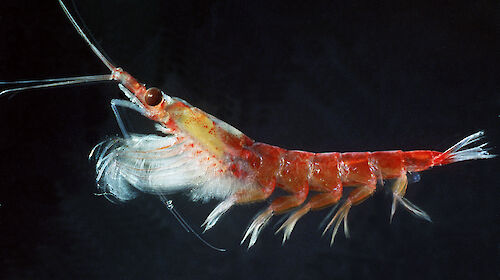Early indications are that variability of krill abundance and distribution occurs on a number of scales, and that krill are not merely drifting with the currents.
The answer affects our understanding of how animals such as penguins, which have a relatively fixed geographic location during their breeding season, interact with this major food source.
It also affects the way in which the krill fishery, the largest in the Antarctic region, is managed.
Dr Steve Nicol, head of the Australian Antarctic Division’s Antarctic Marine Living Resources Program, has led several research expeditions to examine krill life history and distribution but says the answer is complex.
Dr Sharman Stone, Parliamentary Secretary with responsibility for the Australian Antarctic Division, said the findings demonstrated the leading role that Australia’s Antarctic program continues to play in scientific research of the Antarctic continent.
Addressing this year’s Australian Marine Sciences Association Conference in Hobart Dr Nicol said that while much was known about the important crustacean, there was still much to learn about the impact of its harvesting on the survival of the species and on its predators.
"If the krill population in an area is transitory and sourced from production elsewhere, then localised fishing effects can be far less serious than if the local population is produced in situ.
“This is an extremely difficult issue to tackle, requiring concerted study at a number of different time and space scales using a range of complementary techniques.
“During our most recent examination of krill flux, carried out aboard the Antarctic research vessel Aurora Australis in the 2002–03 summer, a range of sophisticated equipment was used to examine the distribution of krill and the oceanographic environment in the area where the penguins were foraging," said Dr Nicol.
“The survey studied foraging penguins and krill; how predators and prey move; the congregation of predators and prey and how they interact. It involved tracking Adélie penguins from the long-running monitoring program at Béchervaise Island off the Mawson coast in eastern Antarctica. These penguins rely heavily on krill for their main food source.
“The work was a follow-on to the first Australian attempt, in 2000–01, to investigate the question of krill flux.
“The results we have so far tell us that changes in local krill distribution and abundance can have marked effects on populations of land-based predators, particularly when they are rearing their young. These changes can result from oceanographic variability or because of changes in the population biology of krill, but the overall distribution and abundance of krill is the product of the interaction between the animals and their environment.”
Dr Nicol said that the long-term project would give clearer answers towards sustainable fisheries in the future. Many Antarctic species such as whales, seals and sea birds as well as penguins depend on a ready supply of krill.
Krill abundance can vary markedly throughout the Antarctic and a shortage of supply means a serious impact on the successful breeding ability of these animals,” Dr Nicol said.
“Monitoring of the movement of krill in the water column is crucial to knowing how much can be harvested sustainably by the fishery,” he said.


